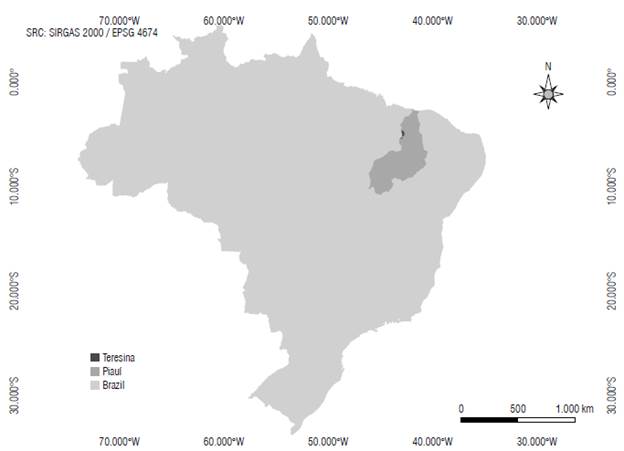Introduction
The use of fertilizers when sowing forage seeds requires care, as the sowing time is very variable and interruption of sowing due to damage to agricultural implements, rain or other problems can increase the contact time of the seeds with the fertilizer (Almeida et al., 2017).
Sowing efficiency depends on the type of fertilizer and the contact time between the fertilizer and the seeds (Lima et al., 2010). Sowing must consider that fertilizer can harm seed germination and seedling emergence, mainly due to saline effect of fertilizers (Pereira et al., 2018).
Some production systems, such as integrated systems, suggest the use of forage together with annual crops, such as in maize-grass intercropping, where sowing of forage seeds is generally carried out together with fertilizers in the feed-box of a seed drill (Almeida et al., 2017; Choudhary et al., 2018).
The choice of forage species in the implementation of a pasture reform and adequate recommendation of mineral nutrients requires consideration by growers. In this sense, forage plants of the genus Megathyrsus maximus have drawn interest among researchers and growers of Brazil, due to their high productivity and wide adaptability to edaphic and climatic conditions of the country, akin to those of their center of origin (Perdra et al., 2021).
Some practices employed in intensive production systems are the application of fertilizers at pre-sowing. In this context, mainly in the Northeastern Cerrado, where planting windows are short, there is a need to optimize planting because growers often apply only phosphorus fertilizer at sowing (Donagemma et al., 2016).
Considering the requirements when mixing fertilizers and forage species in integrated systems and the growing use of species of the genus Megathyrsus, the aim of the present study was to evaluate the effect of the contact time of single superphosphate (SSP) fertilizer on the physiological quality of Massai grass seeds.
Materials and methods
The experiment was carried out at the State University of Piauí, located in Teresina, Piauí state, Brazil (5°04'34.4" S, 42°49'36.9" W) (Fig. 1), under both controlled laboratory conditions and in the field under full sun exposure.
The experimental design was completely randomized, with three replicates (20 g of seed in each). The treatments consisted of seven contact times between seeds and granulated phosphate fertilizer (single superphosphate, 18% P205): 0, 3, 6, 9, 24, 48, and 72 h. The design was the same for both trials (laboratory and full sun field exposure). The seeds of Massai grass (M. maximus) were in contact with SSP according to the mentioned periods, with a fertilizer rate equivalent to 20 kg ha-1 of P205 and a sowing rate of 5 kg ha-1.
The mixture of fertilizer and seeds was kept in a closed plastic package of 0.5 dm3, consisting of 20 g of forage seeds and 80 g of fertilizer. Homogenization (mixture of fertilizer with seeds) was performed according to each treatment; the control received no contact. The seeds had a percentage Pure Life Seed (PLS) of 80% according to information contained on the label of the purchased batch.
After the pre-established contact times (3, 6, 9, 24, 48, or 72 h) of the Massai grass seeds with the phosphate fertilizer, tweezers were used to place 50 seeds on paper for seed germination (paper towel - "germitest"), in triplicate.
The seeds were initially moistened with 12 ml of distilled water, using 2.5 times the mass of the dry paper soaked in water, maintaining the necessary moisture throughout the trial. The papers were rolled and placed in a BOD (biochemical oxygen demand) incubator - Novatécnica: Equipamentos para laboratório", Brazil - for 8 h at 35°C in light and for the remaining 16 h at 25°C in the dark, according to Santos et al. (2013).
Germination was assessed at 7 and 21 d and the seedlings considered normal were computed according to the criteria established in the Rules for Seed Analysis (MAPA, 2009). The length of normal seedlings from the germination test was measured using a millimeter ruler from the apex of the primary root to the apex of the aerial part (MAPA, 2009).
Furthermore, an analogous method was carried out in soil-filled pots by planting 50 seeds in triplicates of each treatment and leaving them in full sun conditions (November to December of 2016, without rain in the period, and average temperature in 28°C). Soil moisture was kept constant, and the duration of the test was the same as the laboratory test, evaluating the emergence at 7 and 21 d. The seeds were incorporated into the soil at a depth of 1 cm. The soil had the following chemical characteristics: pH (water), 7.7; P (Mehlich 1) 12 mg dm-3; K, 0.51 cmolc dm-3; H+Al,1.5 cmolc dm-3; OM, 1.1 g dm-3, and sandy texture (9% clay).
In the full sun trial, the germination speed index (GSI) was also evaluated, using Equation 1 (Maguire, 1962):
where: G1, G2, Gn = number of seedlings germinated at the first, second, until the last count and N1, N2, Nn = number of days from the first, second, until the last count.
Assumptions of normality (Shapiro-Wilk test) and homogeneity of variances (Bartlett test) were tested to determine if the data were suitable for analysis of variance using the F test; when significant, the Scott-Knott mean test (5%) was applied and polynomial regression analysis was performed with the aid of the SISVAR software (Ferreira, 2011).
Results and discussion
Table 1 presents the average values of PG, growth, and seedling emergence of Massai grass as a function of contact times with SSP, which were significant for germination at the first and second counts (measurement days), shoot height of seedlings, emergence at 21 d, and GSI. For the second germination count (21 d) and GSI, no differences were found for up to 3 h of contact; however, for the first germination count (7 d), shoot height and emergence at 21 d, the contact of seeds with fertilizer for 3 h already promoted negative effects on these variables of 23.33, 12.13, and 14.28%, respectively.
TABLE 1 Average values of seed germination of Massai grass at 7 and 21 d, length of radicle and shoot, and seedling emergence percentage at 7 and 21 d as a function of the seed contact time with single superphosphate.
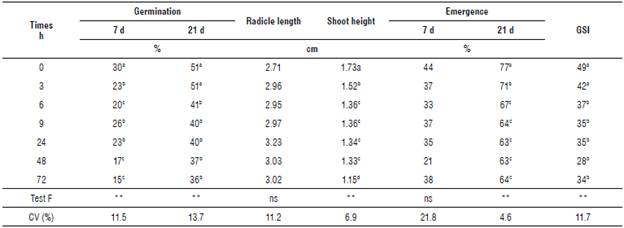
ns, ** - Non significant and significant at 5% probability. 1Means followed by the same letter in the column do not differ according to the Scott-Knott test (5%). GSI - germination speed index.
Germination rates at 7 d (Fig. 2) fitted best to a decreasing linear model (P<0.05). However, for germination at 21 d (Fig. 3), shoot height (Fig. 4), seedling emergence at 21 d (Fig. 5) and GSI (Fig. 6), they were fitted to a decreasing exponential model, with stabilization of the reduction of these variables after 24 h of contact of seeds with the phosphate fertilizer. A similar result has already been verified in other studies evaluating contact times between fertilizers and forage seeds (Maciel et al., 2019; Ferreira et al., 2020).
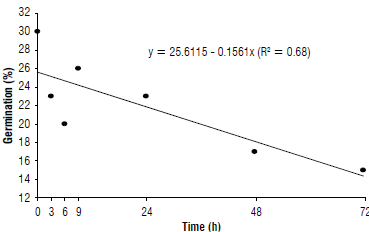
FIGURE 2 Megathyrsus maximus Masai grass seed germination at 7 d as a function of contact times with single superphosphate.
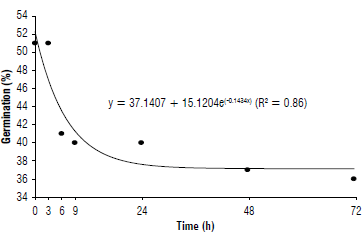
FIGURE 3 Megathyrsus maximus Masai grass seed germination at 21 d as a function of contact times with single superphosphate.

FIGURE 4 Shoot height of Megathyrsus maximus 'Massai' grass seedlings as a function of contact times with single superphosphate.
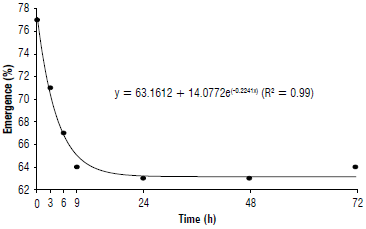
FIGURE 5 Seedling emergence at 21 d of Megathyrsus maximus 'Massai' grass as a function of contact times of seeds with single superphosphate.
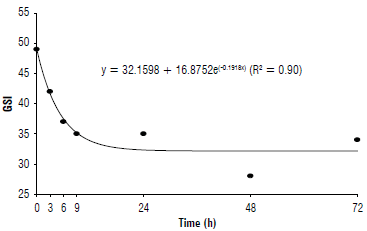
FIGURE 6 Germination speed index (GSI) of Megathyrsus maximus 'Massai' grass as a function of contact times of seeds with single superphosphate.
The stabilization could be due to the saline effect of the fertilizer. From 0 to 9 h of ion-seed contact, seeds had not yet reached their maximum osmotic potential (fs), which only occurs within 24 to 72 h, possibly allowing the fertilizer to break the cell cytoplasmatic membrane, consequently reducing seed germination and seedling development.
However, other studies mention that phosphate fertilizers are obtained by processing the phosphate rock using sulfuric and phosphoric acids (Cheremisina et al, 2019; Sari et al., 2020; Samrane & Bouhaouss, 2022). Therefore, some processing residues could negatively affect the germination and vigor of the seeds, and such negative effect can be accentuated with the contact time with fertilizer (Soratto et al, 2003).
When evaluating the development of the plant, a small growth in height of the seedlings was observed when they remained in contact with the fertilizer for a longer period; thus, possible deleterious effects could be linked not only to seed germination and vigor. The decrease in values obtained in the SH variable is due to the loss of water and nutrients present in the seed in mixture of fertilizer, probably due to its salinity. With little water inside the cells, cell turgidity does not occur, which together with calcium, phosphorus and nitrogen, is responsible for cell division and consequently the increase in SH. This result has also been observed for another source of phosphorus (triple superphosphate) mixed with seeds (Lima et al., 2009).
Another point to be highlighted in the present work is that both trials, full sun field exposure and laboratory, yielded results with the same trend, with a decrease in germination and emergence as the contact times increased.
Studies on the effects of contact time between fertilizers and seeds evaluated millet (Soratto et al., 2003), Brachiaria brizantha (Lima et al., 2009; Lima et al., 2010), and Brachiaria ruziziensis (Dan et al., 2011). All studies reported trends close to those of the present study. Therefore, regardless of the species, contact between fertilizers and forage seeds is deleterious if it remains for long periods.
Single superphosphate (SSP) and monoammonium phosphate (MAP), another source of phosphorus, were kept in contact of with seeds of Brachiaria brizantha cv. Marandu. Considering an acceptable germination rate of 60%, the seeds can be kept in contact with SSP and MAP at a rate of 80 kg P2O5 ha-1 for 71.2 and 16.2 h, respectively (Peres et al., 2012).
The loss of physiological quality of M. maximus cv. Massai seeds was, probably, due to the imbalance in osmotic potential of the seeds, which may be due to the cationic characteristic of the phosphate fertilizer, which prevented water uptake by the seeds (Chien et al., 2011). Due to the ionic strength of several salts, the fertilizer can be in contact with the developing plant tissues, potentially causing phytotoxicity (Pereira et al., 2012).













